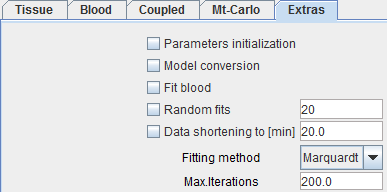Parameters
initialization
|
This configuration is only related to the compartment models and determines which initial values are used for the iterative fitting:
- Disabled: the user-defined parameters are used.
- Enabled: an automatic procedure determines initial parameters which should be reasonably close to the solution. This is done by the linear least squares method. Note that the initial values are not shown to the user. However, to see the values, please switch to the linear least squares method and fit.
|
Model
Conversion
|
Behavior of the parameters when switching between models.
|
Fit blood
|
If this box it is checked on, all parameters of the Input curves which have the fit box checked are also included into the set of fitted parameters. This feature has two uses:
- Fitting the relative time delay between the tissue and the blood data simultaneously with the kinetic rate constants. However, it is easier to directly use the dedicated button.
- (Rarely) Fitting a shape parameter such as the half-time of a metabolite build-up together with the rate constants as explained below.
|
Random
Fits
|
This configuration is only related to models which require iterative fitting:
- Disabled: Only a single fit is performed and the result parameters returned.
- Enabled: Multiple fits are performed, and the result parameters of the fit with minimal chi squared returned. The fits are started with randomized sets of initial parameters using a uniform distribution with ±100% range.
Note: If Parameters initialization is enabled, randomization uses the automatically determined parameters for the random number generation. - In case randomized fitting with a number n of trials is enabled, the label of the fitting buttons is adjusted correspondingly.
Note: The purpose of randomized fitting is to avoid local minima, but there is still a chance that the returned solution may contain unphysiologic parameter combinations.
|
Data
shortening to
|
Enables a sequence of fits with a successively shorter data segment to study the parameter sensitivity to acquisition duration.
|
Fitting
method
|
Selection of the numerical optimization method applied for iterative fitting:
- Marquardt: Marquardt-Levenberg algorithm [59]. Usually works faster and has the additional advantage that it accumulates information about the covariance matrix. Therefore, an estimate of the standard error can be calculated for the fitted parameters. They are shown as %SE (coefficient of variation), ie. as a percentage of the parameter value.
- Powell: Conjugate direction set method [59].
The iterative optimizations terminate, when no substantial improvement can be found any more, or when the Max iterations restriction is hit.
Note: Several models (linear and multi-linear regression) are not fitted iteratively because they have closed form solutions. In these cases the Fitting method settings are not relevant.
|
Max.
iterations
|
Maximal number of iterations which are allowed in the iterative Marquardt and Powell fitting.
|
